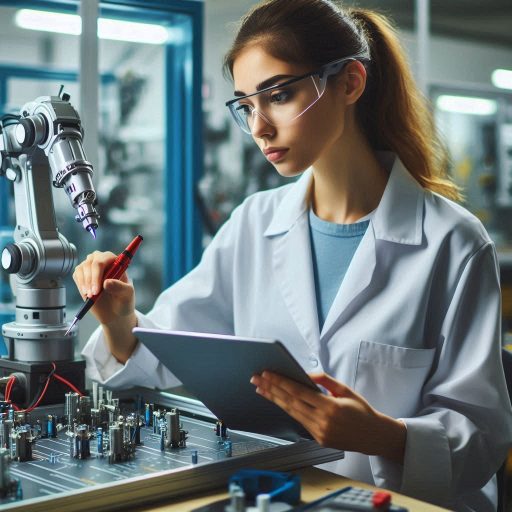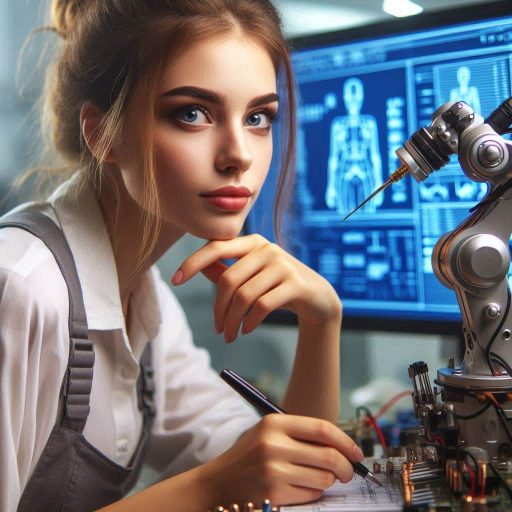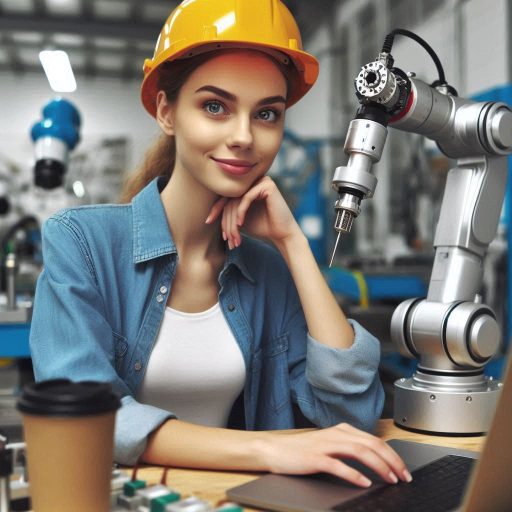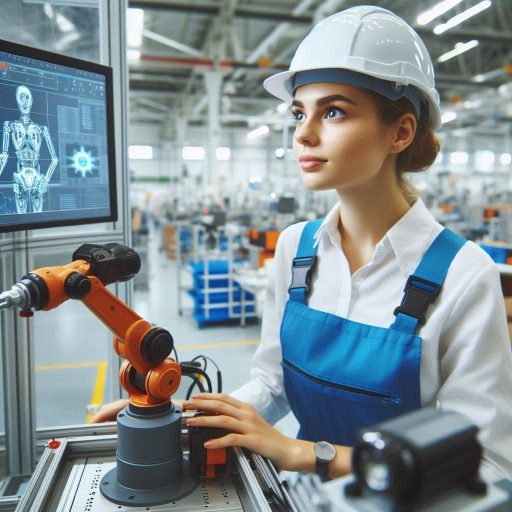Introduction
Robotics engineering has dramatically transformed the automotive industry in recent decades.
The integration of robotics has become a cornerstone of modern manufacturing, driving unprecedented levels of precision, efficiency, and safety.
From assembly lines to painting booths, robots now perform a wide range of tasks that were previously handled manually.
This automation not only accelerates production but also enhances the quality and consistency of vehicles.
In assembly lines, robots handle intricate and repetitive tasks with remarkable accuracy, reducing the likelihood of human error and ensuring uniformity across all products.
These robots are programmed to execute complex movements with high precision, which minimizes defects and enhances the overall quality of the vehicles produced.
The use of robotics in welding and painting has also led to more consistent finishes and stronger, more reliable welds, which are crucial for vehicle durability and safety.
Moreover, robotics engineering has revolutionized quality control and inspection processes within the automotive industry.
Automated systems equipped with advanced sensors and cameras can quickly and accurately detect defects that might be missed by human inspectors.
This not only improves the reliability of the final product but also helps manufacturers maintain high standards of quality and safety.
History of Robotics in Automotive Industry
Exploring the Evolution of Robotics in Car Manufacturing
Robotics in car manufacturing has evolved significantly since its early beginnings.
The automotive industry was one of the first to embrace robotic automation.
In the 1960s, General Motors introduced the first industrial robot, Unimate, into its production line.
Unimate performed tasks such as welding and material handling, which were repetitive and dangerous for human workers.
This marked the beginning of a new era in manufacturing, where robots started to play an integral role in production processes.
Over the following decades, robotics technology advanced rapidly.
By the 1980s, more sophisticated robots were being integrated into automotive production lines.
These robots were capable of performing a wider range of tasks with greater precision.
Automakers began using robots for painting, assembling, and quality control.
This automation improved consistency and efficiency, leading to higher production rates and better-quality vehicles.
Robots also reduced the risk of workplace injuries by handling hazardous tasks that were previously done by humans.
Key Milestones and Advancements Shaping the Industry
Several key milestones have shaped the evolution of robotics in the automotive industry.
One of the most significant advancements came in the 1990s with the introduction of computer-aided design (CAD) and computer-aided manufacturing (CAM).
These technologies allowed for more precise control over robotic systems.
Robots could now execute complex tasks with higher accuracy, improving the overall quality of manufactured vehicles.
The integration of CAD and CAM into robotics marked a significant leap in manufacturing capabilities.
Another major milestone was the development of collaborative robots, or cobots, in the early 2000s.
Unlike traditional industrial robots, cobots are designed to work alongside human workers.
They are equipped with sensors and safety features that allow them to operate safely in close proximity to humans.
Cobots have become increasingly popular in automotive manufacturing because they combine the strengths of human workers and robots.
This collaboration has led to more flexible and efficient production processes.
In recent years, advancements in artificial intelligence (AI) and machine learning have further transformed robotics in the automotive industry.
Modern robots can now learn from data and adapt to changing conditions on the production line.
AI-driven robots are capable of performing complex assembly tasks, detecting defects, and optimizing production workflows.
These smart robots have significantly enhanced the efficiency and flexibility of automotive manufacturing.
Read: Environmental Engineering Software and Tools
Applications of Robotics in Automotive Manufacturing
How robots are used in different stages of the production process
Robots play an essential role in the automotive industry’s production process, transforming how vehicles are manufactured.
They are employed at various stages of production, starting from assembly to the final inspection, with each stage benefiting from the precision and efficiency that robots provide.
Robots enhance the speed and consistency of production, reducing the likelihood of errors and ensuring a high-quality product.
They are programmed to handle repetitive and complex tasks, which not only speeds up production but also minimizes the physical strain on human workers.
By automating critical steps, robots help maintain a steady production flow, ensuring that each phase of manufacturing is completed on time and to the highest standards.
Specific Tasks That Robots Excel at, Such as Welding, Painting, and Assembly
Welding is one of the key tasks where robots demonstrate exceptional proficiency.
Robots perform spot and arc welding with unmatched accuracy, ensuring strong and consistent joints in vehicle structures.
Their ability to work tirelessly and maintain uniformity across hundreds of welds results in enhanced durability and safety of the vehicles.
This consistency is particularly important in ensuring that each vehicle meets stringent safety standards.
In the painting process, robots are crucial for achieving a flawless and uniform finish.
They can apply paint with precise control, reducing waste and ensuring that every vehicle looks perfect.
Robots can operate in hazardous environments, such as paint booths, where human exposure to fumes and chemicals would be dangerous.
Their efficiency in applying multiple layers of paint contributes to the overall quality and aesthetic appeal of the vehicle.
During assembly, robots handle tasks such as installing engines, transmissions, and doors with remarkable speed and accuracy.
Their precision in placing components correctly and securely helps maintain the vehicle’s structural integrity.
Robots are also adept at performing complex assembly tasks, such as wiring and fitting delicate components, which reduces the potential for human error.
This automation ensures that each vehicle is assembled to exact specifications, contributing to the overall reliability and safety of the final product.
Read: Sustainable Wastewater Treatment Methods
Benefits of Robotics Engineering in Automotive Industry
How Robotics Improve Quality Control and Consistency
One of the key advantages of using robotics in the automotive industry is the improved quality control and consistency in production.
Robots are programmed to perform tasks with precision and accuracy, eliminating errors that can occur with human workers.
This ensures that every component and vehicle produced meets the highest quality standards set by the manufacturer.
By relying on robots for critical tasks, car companies can reduce defects and recalls, ultimately improving customer satisfaction and brand reputation.
How Robots Increase Productivity and Lower Manufacturing Costs
Robots are known for their speed and efficiency, which translates to increased productivity in the manufacturing process.
With robots working around the clock, car companies can produce vehicles at a faster rate without compromising quality.
This leads to higher output levels and shorter production times, allowing manufacturers to meet consumer demands more effectively.
Additionally, robots require minimal maintenance and do not need breaks, resulting in lower manufacturing costs for car companies.
By automating labor-intensive tasks, manufacturers can save on labor expenses and reallocate resources to other areas of the business.
Enhanced Safety and Risk Reduction
Robots are designed to handle dangerous and hazardous tasks that may pose risks to human workers.
By delegating these tasks to robots, car manufacturers can protect their employees from potential injuries and accidents.
Automated systems are equipped with sensors and safety features to ensure a safe working environment, reducing the likelihood of workplace incidents.
This not only prioritizes the well-being of workers but also minimizes downtime and production delays caused by workplace injuries.
Overall, robotics help car companies create a safer and more efficient manufacturing environment.
Read: Tips for Writing Environmental Engineering Reports
Challenges and Limitations of Robotics in Automotive Industry
Potential Issues such as High Initial Investment Costs and Maintenance Requirements
Investing in robotics for automotive manufacturing involves significant initial costs.
Companies must purchase advanced robotic systems and integrate them into existing production lines.
These upfront expenses can be substantial, especially for smaller manufacturers with limited budgets.
Beyond the initial investment, maintaining robotic systems also requires ongoing costs.
Robots need regular maintenance to ensure optimal performance and prevent downtime.
This includes routine inspections, software updates, and part replacements, all of which can add up over time.
Companies must allocate resources not only for the purchase of robotic systems but also for their long-term upkeep.
Another challenge is the need for specialized personnel to manage and maintain these robotic systems.
Skilled technicians are essential for troubleshooting issues and performing repairs, which can be expensive.
Additionally, as robotic technology evolves, manufacturers may need to upgrade their systems or invest in new robots to stay competitive.
This continuous cycle of investment can strain budgets and resources, particularly in a rapidly changing industry like automotive manufacturing.
Companies must carefully evaluate the return on investment and long-term benefits before committing to such high costs.
Limitations of Robots in Handling Complex Tasks Compared to Human Workers
While robots excel at repetitive and precise tasks, they have limitations when it comes to handling more complex operations.
Human workers possess a level of adaptability and problem-solving ability that robots currently cannot match.
For instance, when unexpected issues arise during the production process, human workers can quickly assess the situation and make decisions.
Robots, on the other hand, are limited to their programmed functions and may struggle to adapt to new or unforeseen circumstances.
Moreover, tasks that require fine motor skills, creativity, or subjective judgment are still better suited for human workers.
For example, in the automotive industry, tasks like final quality inspections often rely on human judgment to detect subtle defects that a robot might overlook.
Similarly, complex assembly tasks that require flexibility and dexterity are challenging for robots to perform as efficiently as humans.
Robots also face limitations in terms of their operational scope.
They are typically designed for specific tasks and may require reprogramming or reconfiguration to handle different operations.
This rigidity contrasts with the versatility of human workers, who can easily shift between tasks as needed.
Additionally, robots can be vulnerable to technical failures, which can disrupt production lines and require costly repairs.
Read: Public Health and Environmental Engineering

Future Trends in Robotics Engineering for Automotives
In the rapidly evolving field of robotics engineering, the automotive industry is at the forefront of innovation.
As technology continues to advance, new trends are emerging that are reshaping the future of automotive manufacturing.
Predictions for How Robotics Technology Will Evolve
- Increased Automation: Robotics technology is expected to become more automated, reducing the need for human intervention in manufacturing processes.
- Enhanced Efficiency: Robots will become more efficient in performing tasks, leading to increased productivity and cost savings for automotive manufacturers.
- Integration of AI: Artificial intelligence (AI) will play a significant role in robotics engineering, enabling robots to learn and adapt to new situations autonomously.
- IoT Connectivity: Robotics systems will be connected through the Internet of Things (IoT), allowing for real-time data exchange and remote monitoring of operations.
- Advanced Sensors: Robotics technology will be equipped with advanced sensors for improved accuracy and precision in performing tasks within automotive manufacturing.
Impact of Advancements such as Artificial Intelligence and Collaborative Robots
- AI Integration: The integration of AI into robotics technology will revolutionize the way robots operate in automotive manufacturing, making them more intelligent and efficient.
- Improved Safety: Collaborative robots, also known as cobots, will work alongside human workers in automotive plants, improving safety and efficiency on the factory floor.
- Flexible Manufacturing: Collaborative robots will enable automotive manufacturers to easily reconfigure production lines to accommodate changes in demand and product variations.
- Optimized Processes: AI-powered robotics systems will optimize manufacturing processes, leading to higher quality products and reduced production costs for automakers.
- Customization Capabilities: Advanced robotics technology will allow for greater customization of vehicles, meeting the growing demand for personalized automotive products.
Overall, the future of robotics engineering in the automotive industry is bright, with continued advancements in technology leading to greater efficiency, safety, and customization capabilities.
As robotics technology evolves, automotive manufacturers will benefit from increased productivity and cost savings, ultimately providing consumers with higher quality and more innovative vehicles.
Explore Further: Nuclear Engineering: From Research to Application
Education and Training in Robotics Engineering
Skills and Qualifications Needed in Robotics Engineering for the Automotive Industry
To succeed in robotics engineering within the automotive industry, specific skills and qualifications are essential.
A strong educational foundation is crucial, typically requiring a bachelor‘s degree in robotics, mechanical engineering, electrical engineering, or a related field.
This education equips engineers with knowledge of mechanics, electronics, and control systems vital for designing robotic systems used in car manufacturing.
Hands-on experience is highly valued alongside formal education.
Employers seek candidates with practical programming skills, particularly in Python, C++, and Java.
Proficiency in robotics software, such as ROS (Robot Operating System), is also important.
Gaining this experience through internships, co-op programs, or project-based learning is beneficial.
Familiarity with CAD (Computer-Aided Design) software is another key qualification, as it allows for designing and simulating robotic systems before implementation.
A strong grasp of automation and control systems is crucial.
Robotics engineers in the automotive industry design robots that operate autonomously and interact with other machines on the production line.
Knowledge of PLC (Programmable Logic Controllers) and SCADA (Supervisory Control and Data Acquisition) systems is often required, as these tools are common in industrial automation.
Problem-solving skills and the ability to work in interdisciplinary teams are also critical.
Robotics engineers often collaborate with software developers, mechanical engineers, and production managers.
Effective communication and teamwork ensure that robotic systems integrate smoothly into the broader manufacturing process.
By combining these skills and qualifications, engineers can excel in the automotive robotics field.
Importance of Continuous Learning and Professional Development
Continuous learning and professional development are vital in the rapidly evolving field of robotics engineering.
The automotive industry constantly seeks to innovate and improve efficiency, which means that robotics engineers must stay updated on the latest technologies and trends.
This involves regularly updating skills and knowledge through additional certifications, workshops, and advanced courses.
Many robotics engineers pursue certifications in specialized areas such as machine learning, AI, or advanced robotics to stay competitive in the job market.
Professional development can also involve attending industry conferences, networking with peers, and participating in research projects.
These activities provide opportunities to learn about new advancements and share knowledge with others in the field.
Engaging in continuous learning helps engineers remain at the forefront of technological innovation and contributes to their ability to design cutting-edge solutions in automotive manufacturing.
Transform Your Career Today
Unlock a personalized career strategy that drives real results. Get tailored advice and a roadmap designed just for you.
Start NowStaying current in the field also means understanding and adapting to the latest industry standards and regulations.
Robotics engineers must be aware of safety protocols and quality standards, ensuring that the robots they design comply with industry requirements.
This commitment to professional growth not only enhances individual career prospects but also drives the automotive industry forward through innovation and excellence.
See Related Content: Chemical Engineering in Food and Beverage Industry
Case Studies of Successful Implementation of Robotics in Automotive Manufacturing
Examples of car manufacturers that have effectively integrated robotics into their production processes
Car manufacturers have transformed vehicle production by integrating robotics into their processes.
Leading automakers like Tesla, Toyota, and BMW have set new standards for efficiency and precision.
Tesla is a leader in robotics integration.
Tesla‘s Gigafactories use hundreds of advanced robots for critical tasks.
These robots handle spot welding, painting, and assembly with high precision.
Operating 24/7, they significantly boost production rates.
By automating these tasks, Tesla minimizes human error and enhances vehicle quality.
The Model 3 production line demonstrates robotics‘ effectiveness in achieving high output and consistent quality.
Toyota has long been a pioneer in robotics adoption.
Toyota employs robots for welding, painting, and assembly to maintain high-quality standards.
The company‘s ‘Toyota Production System‘ uses robotics to reduce waste and optimize production flow.
Robotics integration has improved efficiency, reduced downtime, and maximized output.
This approach has led to significant cost savings and exceptional quality.
BMW also excels in robotics integration.
BMW‘s factories feature state-of-the-art robotic systems for body construction and final assembly.
Robots at BMW perform tasks like precision welding and intricate assembly with remarkable accuracy.
This automation enables BMW to produce vehicles with complex designs and high customization levels.
By improving production efficiency and quality, BMW strengthens its reputation for excellence.
In summary, Tesla, Toyota, and BMW showcase the transformative impact of robotics in automotive manufacturing.
Their advanced robotic systems drive efficiency, precision, and high-quality production, setting new benchmarks in the industry.
Analyzing the Results: Increased Efficiency, Improved Quality, and Cost Savings
The integration of robotics in automotive manufacturing has led to substantial benefits.
Increased efficiency is one of the most notable outcomes.
Robots work tirelessly, performing repetitive tasks with speed and precision.
This has enabled manufacturers like Tesla, Toyota, and BMW to significantly boost their production rates.
Robots can work continuously without breaks, reducing production time and increasing output.
Improved quality is another critical benefit of robotics integration.
Robots ensure consistent accuracy in tasks like welding, painting, and assembly, which are essential for vehicle safety and durability.
By reducing human error, robots help maintain high-quality standards across all vehicles produced.
This consistency is crucial in meeting customer expectations and regulatory requirements.
Cost savings is also a significant advantage.
While the initial investment in robotics is substantial, the long-term benefits outweigh the costs.
Robots reduce the need for manual labor, lowering operational costs.
Additionally, the efficiency and precision provided by robots minimize waste and rework, further reducing expenses.
Manufacturers like Tesla, Toyota, and BMW have experienced these cost savings, enabling them to reinvest in innovation and growth.
In summary, automakers that have effectively integrated robotics into their production processes have seen remarkable improvements in efficiency, quality, and cost savings.
These advancements position them as leaders in the automotive industry, setting new standards for manufacturing excellence.
Discover More: Field Service Technician Job Description
Learn More: Comparing Telecommunications Technician and IT Technician Roles
Explore Further: Field Service Technician Training Programs
Discover More: How Agricultural Engineers Solve Farming Problems
Conclusion
Robotics engineering is fundamentally revolutionizing the automotive industry, driving significant advancements in efficiency and precision.
The use of robots in manufacturing processes has greatly enhanced assembly line productivity, ensuring higher quality and consistency in vehicle production.
Automated systems perform repetitive tasks with unmatched accuracy, reducing the risk of human error and leading to safer, more reliable vehicles.
Moreover, robotics play a crucial role in the development of autonomous vehicles, transforming the driving experience by introducing advanced driver assistance systems and self-driving technologies.
The integration of robotics into the automotive industry not only streamlines production but also reduces operational costs.
Paving the way for more innovative and cost-effective manufacturing solutions.
Looking ahead, the potential for continued innovation in robotics engineering remains immense.
Advancements in artificial intelligence, machine learning, and robotics technology promise even more sophisticated systems and capabilities.
As the industry evolves, robotics will drive new levels of efficiency, safety, and sustainability in automotive design and manufacturing.
The ongoing research and development in robotics will likely lead to further breakthroughs, enhancing vehicle performance and redefining transportation standards.
[E-Books for Sale]
The Big Book of 500 High-Paying Jobs in America: Unlock Your Earning Potential
$19.99 • 500 High-Paying Jobs • 330 pages
Explore 500 high-paying jobs in America and learn how to boost your career, earn more, and achieve success!
See All 500 High-Paying Jobs of this E-Book
1001 Professions Without a Degree: High-Paying American Jobs You Can Start Now
$19.99 • 1001 Professions Without a Degree • 174 pages
Discover 1001 high-paying jobs without a degree! Unlock career tips, skills, and success strategies for just $19.99!




